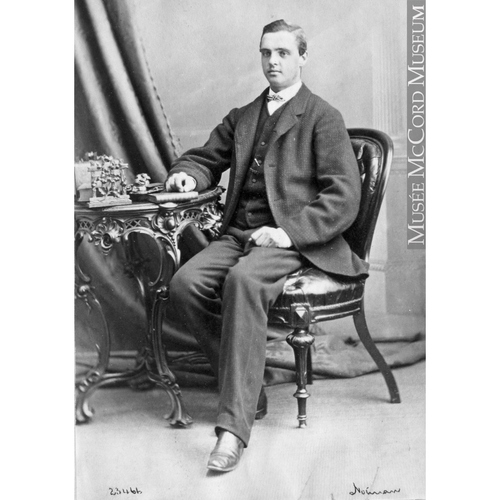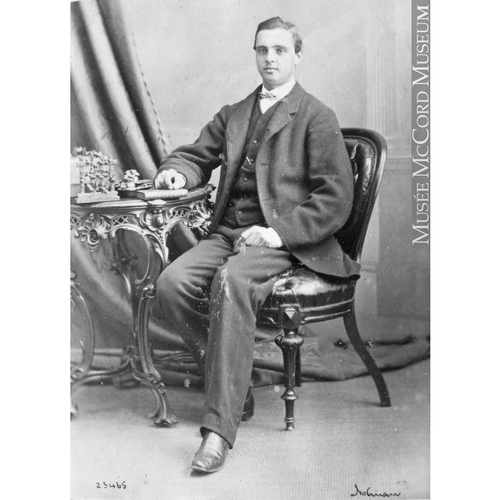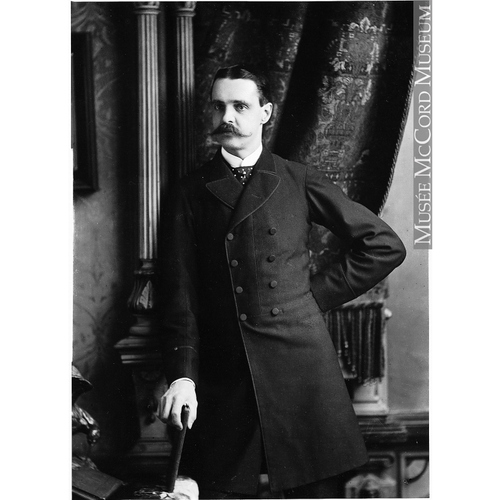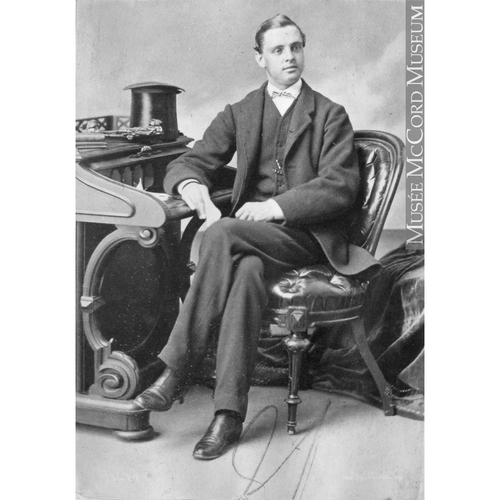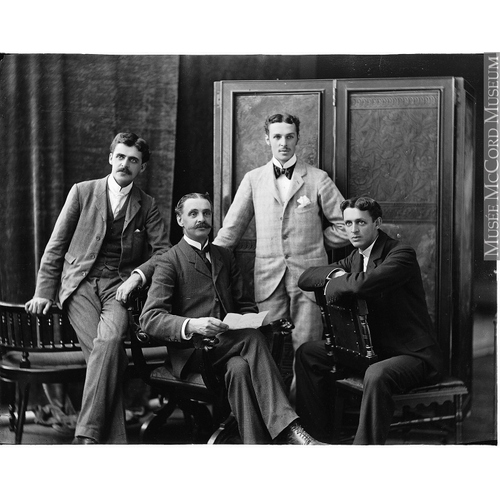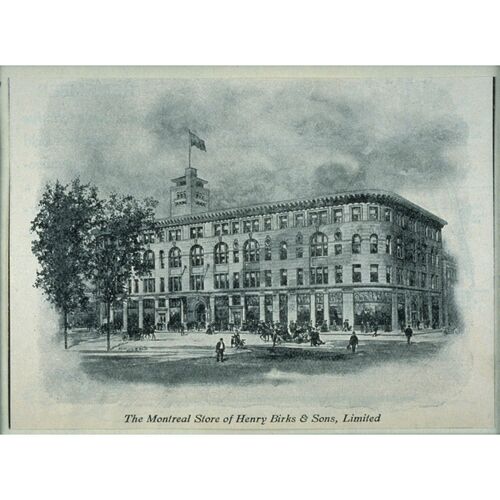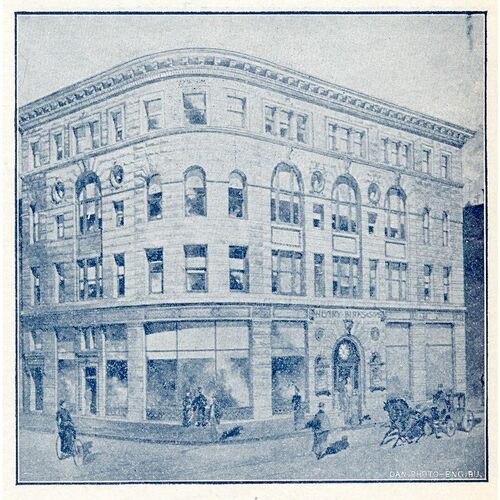As part of the funding agreement between the Dictionary of Canadian Biography and the Canadian Museum of History, we invite readers to take part in a short survey.
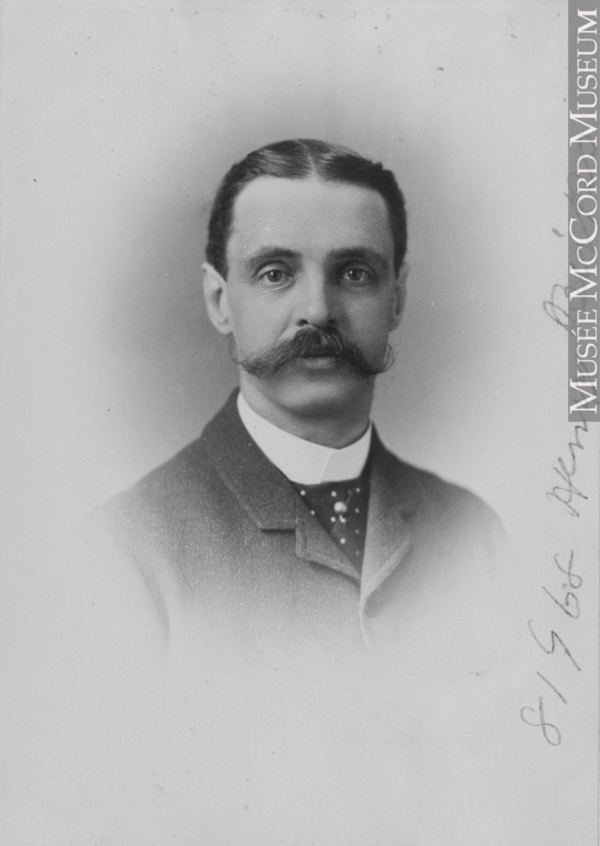
Source: Link
BIRKS, HENRY, businessman specializing in the sale of gold and silver articles, and philanthropist; b. 30 Nov. 1840 in Montreal, son of John Birks, a pharmacist, and Ann Massie; m. 16 Jan. 1868 Harriet Phillips Walker in Toronto, and they had three sons; d. 16 April 1928 in Montreal.
Henry Birks’s parents were from Barnsley, in Yorkshire, England, and they immigrated to Canada in 1832. Before leaving, John Birks had signed a contract to work for a firm in Montreal, where he soon opened a pharmacy.
Henry took commercial studies at the High School of Montreal, which he completed in 1856. He then spent a winter in Rivière-du-Loup (Louiseville) with notary Jean-Baptiste-Arthur Chamberland in order to learn French. On 22 April 1857 he began working as a clerk for Joseph Savage and Theodore Lyman, whose jewellery store on Rue Notre-Dame in Montreal was considered the finest of its kind in Canada. Birks is believed to have met Lyman earlier, when he attended Sunday school at the Congregational Church and was taught by him. A founding member of the Young Men’s Christian Association in Montreal [see Alfred Sandham*], Lyman must surely have interested the young man in this cause, since Birks would contribute $25,000 to the YMCA in 1909. Birks became a partner in Savage and Lyman’s company in 1868. Unfortunately, the depression of 1873 hit the firm head on, and it was forced into bankruptcy in 1878, a year after Birks had left it. The assignee put him in charge of liquidating the assets.
Around 27 Feb. 1879, with a capital of $3,000, Birks opened a small shop of the same kind at 222 Rue Saint-Jacques, in the heart of the city’s business section. His enterprise was called Henry Birks and Company and he immediately instituted new business practices for customers: cash sales only and the same price for everyone. During its first year the store had a turnover of $30,000. This figure increased by 25 per cent over the next four years and in 1885 Birks moved his store to larger quarters at 232 Rue Saint-Jacques. In 1893, with annual sales 500 per cent higher than those of his first year, he went into partnership with his three sons, William Massey, John Henry, and Gerald Walker as Henry Birks and Sons. The first notable result of this partnership came the following year, when the store was moved to new premises on Phillips square, at the corner of Rue Sainte-Catherine and Avenue Union [see Edward Maxwell]. In moving, the business was following the development of the city, since at that time Rue Saint-Catherine was becoming its main commercial artery. A little later a period of expansion outside Montreal would begin.
The Birks firm started as a gift shop that specialized in retail sales of jewellery, gold and silver pieces, and clocks, advertising articles in silver plate as well as sterling silver. A workshop to make jewellery was opened over the store in 1887. The following year an “artistic department” sold articles made in European workshops but purchased from American suppliers. The company also bought supplies on the local market. On 17 Feb. 1896, for instance, John Leslie, the administrator of the large silverware manufacturer Hendery and Leslie, signed an agreement with the Birks company making it the exclusive distributor for the city of Montreal of its non-religious gold and silver articles, with the exception of commemorative spoons. Henry Birks and Sons also published its first annual catalogue in 1896. The next year the company purchased Hendery and Leslie, along with its designs, equipment, and labour force. Thereafter the company founded by Birks produced its own merchandise and hence exercised stricter control over what it sold. At the same time, it also stated its intention to specialize in gold and silver. From then on the volume of business increased and the sales network expanded. Noticing that a large number of mail orders came from Ottawa, in 1901 the company opened a store there, its first outside Montreal. This move would be repeated many times, and before World War II the company would in effect enjoy a monopoly over the market for gold and silver articles in the country. It secured this control by purchasing numerous stores and companies across Canada (in Ottawa in 1902 and 1911, Winnipeg in 1903 and 1913, Toronto in 1905, Vancouver in 1906, Montreal in 1907, Halifax in 1919, and Calgary in 1920) and opening branches in Canada and abroad (in London in 1925 and Antwerp in 1929).
Henry Birks belonged to a particular group of Canadians in the second half of the 19th century, and in a sense he was their prototype. The son of immigrants, he acquired an education focused mainly on commerce, and then proceeded to put it into practice by working in a large firm. As soon as circumstances permitted, he started his own company, which continued to prosper until it became a Canada-wide empire. The story of the founding and evolution of the Birks company shows the radical change that took place in the gold and silver trade at that time. Obviously, Birks did not work with hammer and anvil. He started out in business by obtaining supplies from various manufacturers and went on to integrate production into his own firm by buying out his main supplier. He and his sons gave the Canadian gold and silver business a specifically industrial base. The artist had made way for the entrepreneur.
Between 1936 and 1979 Henry Birks’s grandson Henry Gifford Birks amassed a vast collection of Canadian silverware. The collection, which was donated to the National Gallery of Canada on 1 Dec. 1979, is the principal record of the output of Henry Birks and Company, Henry Birks and Sons, and Henry Birks and Sons Limited, and of its predecessors and suppliers.
ANQ-M, CE601-S95, 20 juin 1841. AO, RG 80-27-2, 67: 55. Musée du Québec (Québec), Fonds Gérard-Morisset, dossier Birks, Henry and Sons. Gazette (Montreal), 17 April 1928. La Minerve, 28 févr., 5 août, 10 sept., 11 déc. 1879; 4 déc. 1888. Henry Birks and Sons, Catalogue ([Montreal?, 1913?]); Catalogue, 1906: the gold and silversmiths, diamond merchants (Toronto, 1906). R. [A. C.] Fox, Presentation pieces and trophies from the Henry Birks Collection of Canadian Silver (exhibition catalogue, National Gallery of Canada, Ottawa, 1985). A. R. George, The house of Birks (n.p., 1946). J. E. Langdon, Canadian silversmiths, 1700–1900 (Toronto, 1966). K. O. MacLeod, The first century: the story of a Canadian company (Montreal, 1979). T. D. Nanavati, “Nineteenth century Canadian presentation silver” (ma thesis, Univ. of Toronto, 1977). Ryrie-Birks Limited, The romance of the silver craft (Toronto, 1925). Ryrie Bros, Diamond merchants, jewellers and silversmiths, 1917 (Toronto, 1917). Ramsay Traquair, The old silver of Quebec (Toronto, 1940). René Villeneuve, Quebec silver from the collection of the National Gallery of Canada (exhibition catalogue, Ottawa, 1998).
Cite This Article
René Villeneuve, “BIRKS, HENRY,” in Dictionary of Canadian Biography, vol. 15, University of Toronto/Université Laval, 2003–, accessed March 28, 2025, https://www.biographi.ca/en/bio/birks_henry_15E.html.
The citation above shows the format for footnotes and endnotes according to the Chicago manual of style (16th edition). Information to be used in other citation formats:
| Permalink: | https://www.biographi.ca/en/bio/birks_henry_15E.html |
| Author of Article: | René Villeneuve |
| Title of Article: | BIRKS, HENRY |
| Publication Name: | Dictionary of Canadian Biography, vol. 15 |
| Publisher: | University of Toronto/Université Laval |
| Year of revision: | 2005 |
| Access Date: | March 28, 2025 |


